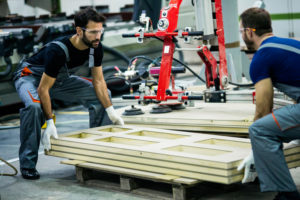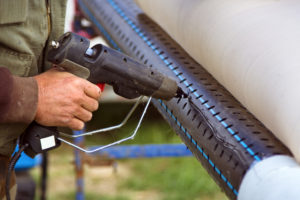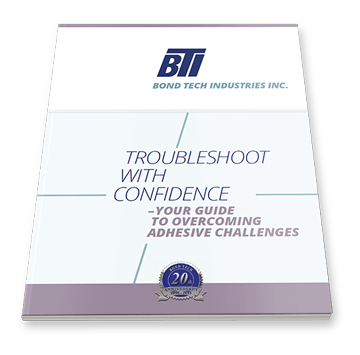Hot melt adhesive is a great, versatile bonding option for plenty of applications. Is this type the best adhesive for your application?
If your application is unique, you’ll get a quicker answer by calling us here.
Hot melt adhesives are essentially plastics (well, thermoplastic polymers, to be precise) that melt at high temperatures and re-solidify during cooling to create strong bonds.
Its greatest strength is its versatility. The base polymer can be modified with other materials to customize its properties for bonding a wide variety of materials in hundreds of commercial and home applications.
- Appliances – trim and gasket installation.
- Automobiles – interior trim and seating assembly.
- Furniture – cabinet and panel assembly.
- Electronics – encapsulation and wire tacking.
- Packaging – Case closing, carton and bad sealing, wrapping and pallet stabilization.
For commercial or businesses, household, hobby and craft applications, inexpensive glue guns and glue sticks are used for parts assembly, repairs and bonding dissimilar materials. Variable heat glue guns enable precise control of viscosity and set times.
Hot Melt Adhesive Configurations
Most hot glue comes in the form of cylindrical sticks. Of these, half-inch or 7/16th-inch diameters are most common.
Depending on the particular application, however, hot glue may be formed as chips, pellets, cubes or blocks for use in specific adhesive application equipment.
Benefits of Hot Glue
Hot melt glue sticks has a number of unique advantages over other types of adhesives:
- Little or no environmental precautions for disposal.
- Minimal waste.
- No volatile organic compounds.
- Rapid drying and curing.
- No loss of thickness during curing.
- Creates tamper-resistant seals.
- Applicators are simple and low-cost.
- Accepts color additives to match the materials being bonded.
Depending on the specific formulation, hot glue can set quickly or the set time can be extended to allow exact positioning of parts when assembled.
Glues with reactive agents allow additional curing and bond strength through the use of moisture or UV radiation. Many hot glue formulas exceed the bonding strength of epoxy.
Adhesive Conditions Unsuitable for Hot Glue
Though other adhesives cannot match its versatility, hot glue is not the best solution for all bonding situations:
- The high melting temperature may damage delicate materials.
- Some formulas cannot withstand certain solvents.
Take care to avoid burns from melted glue, which can rest at temperatures well above that of boiling water.
However, glue application equipment puts the glue only where it is needed and the glue quickly cools, so attentive workmanship should be protection enough.
Best Materials for Bonding with Hot Glue
Hot melt adhesives are suitable for bonding more types of materials than any other single type of adhesive within the limitations mentioned above.
They are suitable for:
- Paper.
- Wood.
- Ceramic.
- Plastics.
- Paper.
- Fabrics.
- Glass.
- Styrofoam.
- Metal and organic substrates.
Non-porous materials like glass and metal should be bonded with high tack polyamide hot glues for maximum adhesion.
Order Today and Choose Reliability
In industry, workshops or the home, hot melt adhesives and commercial rubber adhesives provide the most versatile and convenient solution for most applications.
New polymers, formulations and specialized application equipment are still being produced, which guarantee that hot melt adhesive will continue to find new, innovative applications in the future.








